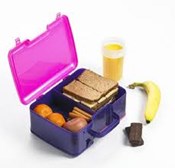Keeping your children healthy so they are better able to learn in school is something that all parents need to keep in mind. Following just a few easy steps will increase the safety of the nutritious lunch you packed for your child.
Many parents pack lunches for their children. Even when outdoor temperatures are cool, it is important to keep food safety in mind when packing school lunches. A simple lunch packed at home can increase the risk of food borne illness if the foods are not handled and stored properly. If your child comes home from daycare or school saying they have a stomachache, it may not be a virus that’s going around; it could be caused from the lunch brought from home. Food borne illness is an issue of concern for all age groups. The Centers for Disease Control and Prevention estimates 48 million people in the United States become ill from foodborne bugs every year. That is about one of every six Americans. About 3,000 of those cases are fatal.
When packing a lunch for your child or yourself, start with food that has been properly handled. Perishable foods must be kept cold or frozen at the grocery store and at home. Foods should never be left at room temperature for more than two hours, or not more than an hour if the temperature is above 90 degrees.
To prevent cross contamination it is important to keep everything clean, including your hands, utensils and kitchen surfaces. Be sure to use a clean cutting board, and use separate cutting boards for foods that will be cooked and those that will not be cooked.
When preparing lunches, pack only enough food that can be eaten at lunchtime. Teach your child to throw away uneaten food. This way there are no worries about storage or safety of leftovers.
Cold foods must be kept cold, hot foods need to be kept hot. Insulated, soft-sided lunch boxes are best for keeping cold food cold. You may also include a frozen gel pack or even a frozen juice box. Even better, place perishable foods between a frozen gel pack and juice box. Cooked foods should be prepared far enough in advance to allow them to be fully cooled before putting them in the lunch box. Some foods such as fruits, vegetables, hard cheese, canned meat and fish, chips, breads, peanut butter, jelly, mustard and pickles are safe without a cold source.
Just as you keep cold foods cold, hot foods must be kept hot. Soup, chili and stew can be packed in an insulated container. Fill the container with boiling water and let it stand five minutes. Empty out the water then put in the thoroughly heated food. Keep the lid tightly closed until lunchtime.
Keeping your children healthy so they are better able to learn in school is something that all parents need to keep in mind. Following just a few easy steps will increase the safety of the nutritious lunch you packed for your child.







